This month I baked along with the Bread Baking Babes and Friends. The bread of the month was Hildegard’s Spelt Bread. It is 100% spelt bread. I’ve made spelt bread before but with a mixture of whole grain spelt and white bread flour or all-purpose flour. Making a bread using all spelt flour and spelt flakes was a new experience for me.
I almost passed this one up simply because I didn’t have any spelt flakes. However, after reading the background information about St. Hildegard, the twelfth century healer, on Astrid of Paulchens FoodBlog, I was really intrigued and just couldn’t pass this one up. I found some white spelt flour and the spelt flakes at whole foods market so I decided to give that a try instead of using whole grain spelt.
I found it very interesting that Eden Foods, the makers of the spelt flakes, included this quote from St. Hildegard on their packaging.
“Spelt produces a strong body and healthy blood for those who eat it and makes the spirit of man light and cheerful.”
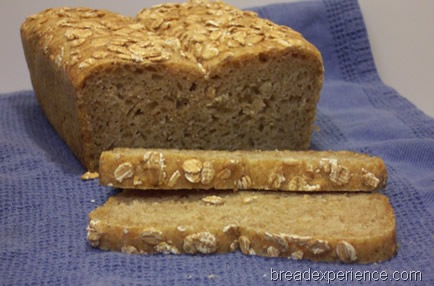 What’s all the fuss about spelt flour?
What’s all the fuss about spelt flour?
“Spelt is one of the super grains. It contains the eight essential amino acids and it is about 60% higher in protein than wheat and contains B vitamins, iron, potassium, magnesium, and fiber. It has a deliciously light, nutty flavor and has been grown and eaten around the world for the last 5,000 years. Even though spelt is high in protein, it is a non-hybrid grain and contains low gluten so it is tolerable by some wheat-sensitive individuals. Source: Cooking with Chef Brad: Those Wonderful Grains II by Brad E. Peterson.
How do you use spelt in breads?
You can substitute spelt in anything in which wheat flour is used. However, according to Purity Foods, the company that reintroduced spelt into North America in 1987, there are some important considerations that need to be taken into account when working with spelt. Source: http://www.ochef.com/108.htm
1) You must use the correct amount of water. Too much, and the dough is sticky and weak and will not be able to hold the gasses that are produced during the fermentation process. Too little, and the dough will be dry and dense. It will not rise properly because the water never fully gets into the protein and there is nothing to hold the loaf up. Also, the dense loaf is too tight to allow the yeast gases to expand the loaf.
2) You must also mix it just right. Too little mixing causes the dough to be crumbly (one of the problems you mention) and it will not develop the necessary protein to cause it to expand properly. A dough mixed too long will break down the fragile protein strands that hold in the gases. The first few minutes of mixing are critical, the company says. From the moment you add the water to the flour, you should take no more than 4 minutes to mix the dough completely.
Hildegard’s Spelt Bread
Makes
: 2 loaves
Armed with my spelt flour and spelt flakes and St. Hildegard’s recipe, I set out to make the spelt bread.
Here is the recipe as Astrid presented it. My notes are in italics.
Ingredients:
- 400 grams spelt flakes
- 600 grams white spelt flour
- 15 grams salt
- 40 grams fresh yeast (or 16 grams active dry)
- 200 ml milk, lukewarm
- 500 ml water, lukewarm
- 2 tablespoons lemon juice
- 1 tablespoon sunflower seed oil
Directions:
Mix spelt flakes and spelt flour with the salt. Dissolve yeast in milk and combine everything to a sponge. Cover the bowl with a kitchen towel and let rest for about 15-20 minutes. This produces a very crumbly dough. According to the directions, you’re not supposed to worry about that, but I didn’t want the bread to be dry and dense (as the above observations suggest) so I added a little more milk.
Add water and lemon juice to the sponge and knead for at least 15 minutes gradually adding the sunflower oil. I used the food processor for this part. I had been sick so I didn’t have the energy to knead dough for 15 minutes by hand. I also added a little less water since I had added additional milk to the sponge.
Form dough ball and coat with warm water. It wasn’t exactly a dough ball.
Cover again with kitchen towel and let double in size. Knead for another 2-3 minutes.
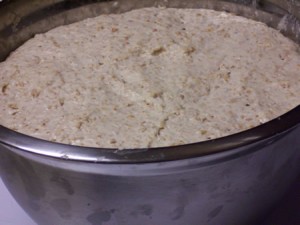
Cut dough in 2 equal halves and place each in a prepared baking pan. The dough was a little bit sticky so I spread it in the two loaf pans rather than cutting it.
Cut the surface of both breads about 5 mm deep and let rise again until doubled in size. (Top with more spelt flakes, if you wish)
Bake the first 15 minutes at 200 °C [400F], then lower heat to 195 °C [385F] and bake for another 30 minutes.
Let the loaves cool on a wire cooling rack.
I was very pleased with the results of this spelt bread. I couldn’t seem to get enough of it. I think it’s because I had been sick and my body was craving the nutrients in it. So there may be something to what they say about the healing qualities of spelt. All I know is that I loved this bread and so did my boyfriend.
I froze one of the loaves so we’ll see how well it freezes. I’m still enjoying the other loaf. I’ve been having slices toasted with butter for breakfast and snacks. I feel like I’m eating really healthy. Yum!
Happy Baking!
Cathy
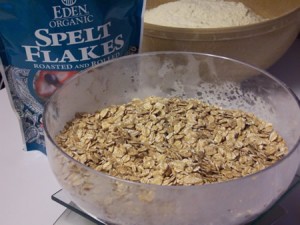
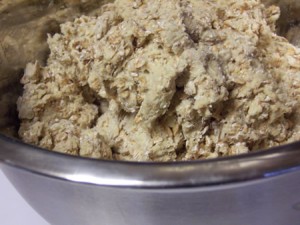
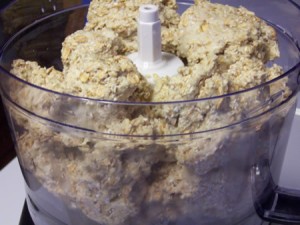
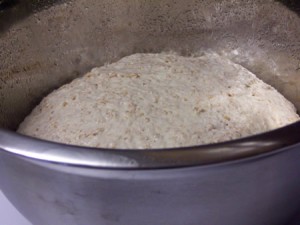
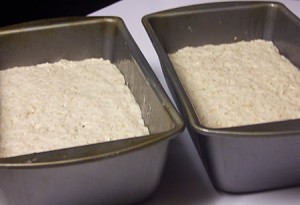
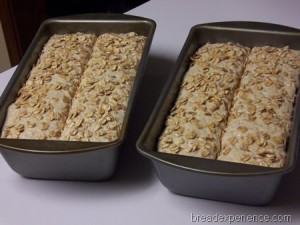
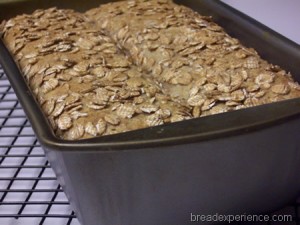
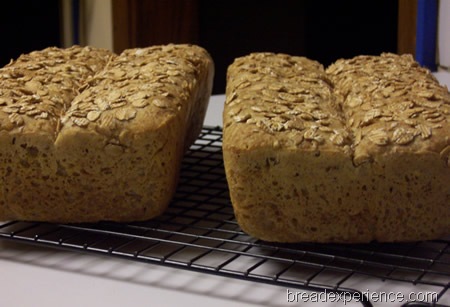
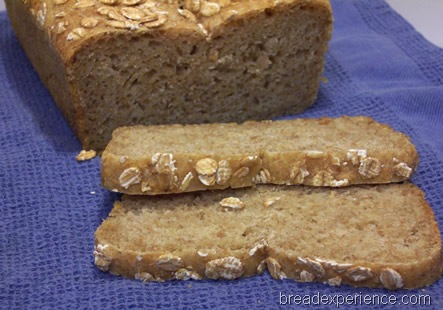
Astrid says
how lovely your bread turned out!
Farzana says
Your bread looks delicious! And who said you shouldnt be kneading spelt four for more than 5 minutes !!?? Have you ever tried making this bread without the flakes and made it just a plain spelt bread? Any tips would be really appreciated.
Cathy (breadexperience) says
Hello Farzana,
Thanks for visiting my blog! This bread is delicious! I have not tried making this particular spelt bread without the flakes although I have made other spelt breads. Spelt shouldn’t be over kneaded because it is not as tolerant as modern wheat in terms of it’s ability to be handled without breaking down. If you over knead it, it could go slack. I probably don’t adhere to the 5 minutes, but I try to handle with a light hand.
Anonymous says
hi, new to your site – looking to avoid wheat, more about GMO and hybrid form not like when I was a child – serious stuff being done to our foods and I am taking steps to take care of myself and loved ones to not be an experiment rat in covert food alterations no one wants to label so you have a choice – wheat I found is one that has been tampered with to a poor result after thousands of years being a food even mentioned as far back as BIBLE and earlier civilizations – why change it for the worse?
I have a bread machine, so I was looking to see if you have used one, altho I may have to select a knead/bake timer setting to accommodate each grains (SPELT is my first choice – healthier and same as centuries old heritage form), or I may have to see if I can do it the old fashioned way in conventional oven after kneading by hand. Any tips with a machine? any other breads of organic type besides wheat you may suggest for a newbie alternative grain bread maker to start experimenting for a new bread of sustenance?
Cathy W. says
Hello, welcome! Spelt is a good choice and Einkorn. I’ve been experimenting with both of those grains as well as KAMUT. I really enjoy working with ancient grains.
I have not made spelt bread in the bread machine. Spelt doesn’t do well if you overwork it so you would be better off doing it by hand or in a stand mixer on first speed. I have a section on Spelt https://www.breadexperience.com/spelt-bread.html and Einkorn https://www.breadexperience.com/einkorn.html. Hope this helps.
Happy Baking!
Cathy
Cathy W. says
This particular bread actually did well in the food processor so that’s an option as well.
linda mace-michalik says
LIke you spelt flakes are hareder to get than spelt flour. Would it be ok to use porridge oat flakes instead of spelt flakes do you think? LinaMM. Your sight looks delicious and wholesome!
Cathy W. says
Hi Linda, oat flakes should work fine. You just won’t have an all-spelt bread.